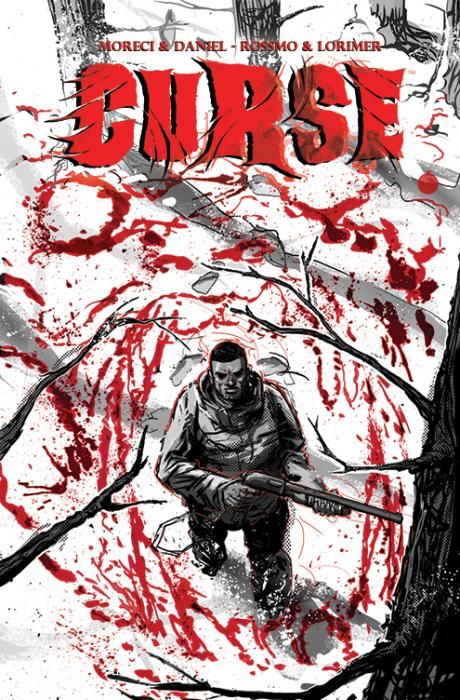There's something to be said for simply doing a thing well, and the first issue of Michael Moreci, Tim Daniel, Riley Rossmo and Colin Lorimer's "Curse" is a perfect example of why. This series isn't going to win any points for its concepts: as a father-son story with werewolves, it doesn't offer anything that pop culture hasn't seen quite a bit of recently. In its execution, however, this issue excels.
It all starts with structure, and Moreci and Daniel have wisely given "Curse" a chilling frame story that sets the stakes and tensions high. They open with a glimpse into the future, where their protagonist Laney has captured the not-yet-lycan werewolf and chained it in his basement, but the calendar is ticking down to the full moon. That tense opening sequence buys them the time to devote most of this issue to developing Laney as a character. Without knowing where things were headed, I don't know if I would have sat through the retrospective on Laney's cut-short college football career, his custody arguments with his sister-in-law, or his chats with the babysitter. And yet, my sense of him as a character is much stronger because I did. In a four-issue mini, the writers have to get the reader caring about the characters quickly, but they've also got to get the story rolling. This structure let Moreci and Daniel do both.
The slow pace through Laney's day also makes everything feel deliberate and hushed, as if the town is waiting for something to strike. Rossmo and Lorimer paint a dark winter world to accentuate this mood, full of green grays, muddy blues, and stark, stark whites. However, rather than stick to a single style, they break form and vary their approach dramatically for one scene. When flashing back to one of the werewolf's kills, they sketch everything in frantic, rough lines with grayscale coloring. It's jarring, and it drives home the frenzy and violence of the attack. In the present, they utilize a very cool blurring effect to convey motion and disorientation.
The closing chase is particularly memorable. As Laney pursues the werewolf through the woods, the two switch their initial roles in the food chain: Laney becomes the hunter, and the werewolf becomes the hunted. Moreci and Daniel demonstrate this change subtly by interspersing the chase with snapshots of their characters' faces. Panic enters one set of eyes and leaves the other. At the same time, the werewolf is slowly morphing from beast back to man. When he finally falls in the final page, the layout is gorgeous and gory -- a striking example of what one can do with white space.
A few problems remain. The werewolf's dialogue is a little clunky, the emotional touch points are a little cliche, and it's unclear why a creature that's earlier described as "fast...and relentless" is suddenly unable to outrun a middle-aged man in snow boots.
Still, it's effective. This is advertised as a survival story, and it all feels fittingly cold and fraught, but what appealed to me most was the creative team's approach to this genre thus far. Survival in this world is a waiting game rather than a fistfight. The characters have to outlast, not outmatch, their opponents, and the former can be much harder to do.

